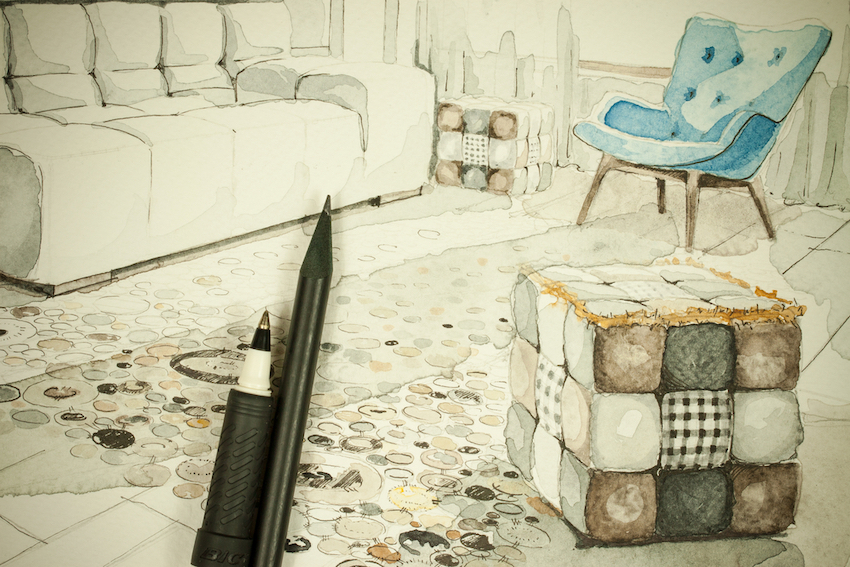The Beginner’s Guide to Perspective Drawing

You’ve probably heard the phrase “that really puts things into perspective” before. It involves taking a step back, seeing the bigger picture, and then using this new information to create our own unique perception of the scenes and situations that surround us.
In the art world, perspective is still about your point of view, the way you see things and the way objects relate to each other. However, it’s also about developing your spatial awareness so that you’re able to accurately represent how you’re seeing the world in front of you.
What is perspective drawing?
In its simplest form, perspective drawing is the art of making objects look three dimensional. For example, if you are drawing a highway with telegraph poles lining either side of it, there will be a point in the distance where the road and poles become very small and essentially collide together. This would be classified as a single point perspective drawing.
The style is often used for interior views or trompe l’oeil (trick of the eye effects), to add interest and depth to pieces of art. Objects must be placed so that the front sides are parallel to the picture plane, with the side edges receding to a single point.
There are a few basic steps to follow when creating a perspective drawing:
- Draw the forward face or the edge of the object
- Mark the vanishing point
- Draw some guidelines from each corner of the shape to the vanishing point
- Draw the verticals and horizontals between the guidelines
- Then use the guidelines to draw the rest of the shape.
Different terms used in perspective drawing
Linear perspective
Linear perspective is the geometric method of representing the apparent diminishing of scale as the distance from the object to the viewer increases. Each set of horizontal lines drawn will have their own vanishing point, and in the sake of simplicity, artists will usually focus on correctly rendering either one, two or three different vanishing points. The concept of linear perspective can be attributed to Florentinian architect Brunelleschi, and was developed continually by Renaissance artists.
One, two and three point perspective
There are different types of perspective drawings with varying numbers of vanishing points within them.
One point perspective is where the horizontals and verticals of the drawing run across the field of view, remaining parallel as their vanishing points are at ‘infinity’. The horizontals vanish towards a point near the centre of the drawing.
Two point perspective is where the viewer is positioned so that the objects (such as buildings) are viewed from one corner, creating two sets of horizontals that diminish towards vanishing points at the outer edges of the drawing. This is the most common type used when drawing buildings in a wider landscape.
Finally, three point perspective is where the viewer is looking either up or down, so that the verticals converge on a vanishing point at the top or bottom of the drawing.
Atmospheric perspective
Atmospheric perspective is different to all the other types of perspective, in that it uses control of focus, shading, contrast and detail to duplicate the visual effects of close objects being realistically clear to the eye. Distant objects are kept less distinct with muted tones and shading, to give the same perspective effect as the other types of drawing.
The ground plane
The ground plane refers to the horizontal surface below the ‘horizon’ depicted in a drawing. It could be either land, water or any other kind of landscape element, and can be either inclined or declined.
The orthogonal lines
These are the lines directed towards a vanishing point. The word ‘orthogonal’ actually means ‘right angle’, and refers to the right angles formed by lines within 3D objects, such as the corners of a cube.
The vantage point
The vantage point (not to be confused with the vanishing point) is the place from which a scene or object is being viewed. The vantage point is dictated by the positioning of the horizon and the placement of the vanishing points within a perspective drawing.
Types of perspective drawings
There are different ways to classify the ‘types’ of perspective drawings, one of these being the number of vanishing points within the drawing (as discussed above). However another way to classify them is with the eye-level that the scene has been sketched from.
Central eye level
Using a central eye level perspective for your drawings is useful for scenes where you want to create an equal balance between the sky and the foreground within the landscape. Wherever you choose to place the eye level will have a crucial effect on the composition of your piece, however this is a great perspective to choose if you’re unsure about the scale, space or proportions of the image. This is a good one for beginners!
High eye level
A high eye level drawing focuses more attention on the middle and distant areas of the artwork. It gives you a limited view of the objects depicted, as you are essentially looking down on them. Whether or not you choose to use this perspective will all depend on what kind of scene you are drawing, as it usually doesn’t work well for scenes that are foreground-heavy in terms of their subjects.
Low eye level
A low eye level drawing is a fantastic choice for when you want your scene to contain some real drama. By lowering the viewpoint, you emphasise the height and power of the objects in the foreground, providing the viewer with a stand-out drawing where all attention is drawn to the subjects.
Have a go at perspective drawing
For any budding or experienced artist, perspective drawing is an art classification that is definitely one to master. Practicing drawing different scenes and objects in your sketchbook will establish your skills for identifying scale, space and realism.
For all the equipment that you need to try your hand at perspective drawing, browse the range at Discount Art n’ Craft Warehouse.
